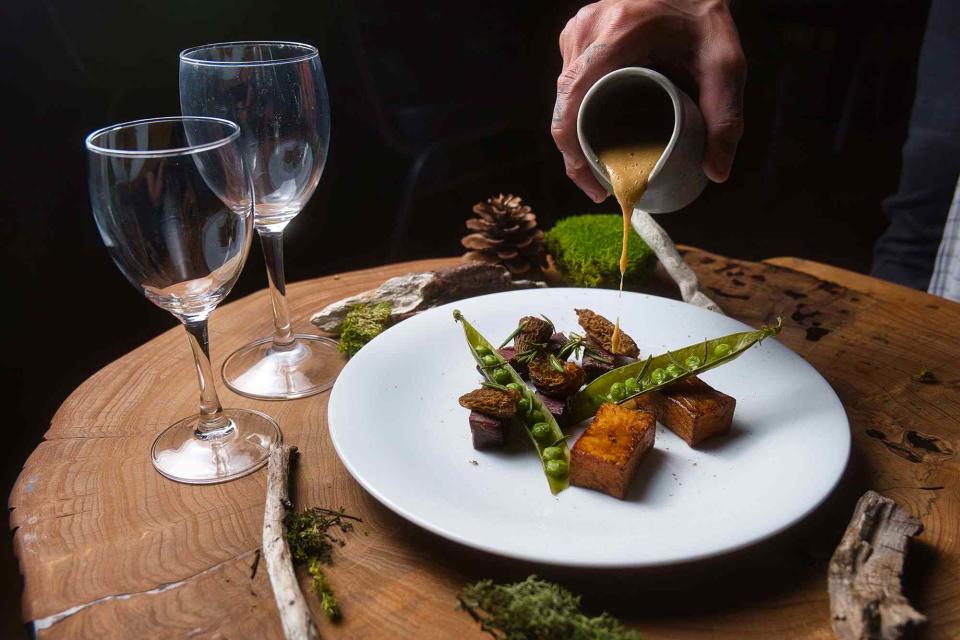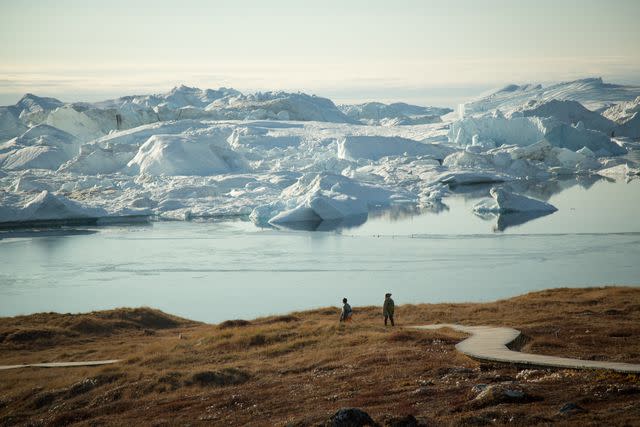I Learned About Greenland's Indigenous History, Tasted Musk Ox, and Sailed Remote Fjords on This Quark Expeditions Cruise
On board the 199-passenger Ultramarine, one travel writer found an enriching education in Inuit traditions and flavors.

Courtesy of Quark Expeditions
Dry-salted caribou, a dish served on Quark Expeditions' Tundra to Table trips.During dinner, Peter Berthelsen described his first hunt, which took place when he was nine years old. Accompanied by his father and uncles, he walked six hours into the mountains above Sermilik Fjord, in eastern Greenland. “We saw a herd of musk oxen, and my father said to me, ‘If you catch one, you must carry it yourself,’ ” Berthelsen remembered. “So I aimed for one of the calves, which was still bigger than me. I saw the opportunity to shoot, and the calf fell. I hit the heart. I was so happy.”
Berthelsen and fellow Greenlandic Inuit chef Miki Siegstad had cooked a special dinner on board the 199-passenger expedition ship Ultramarine, and I was one of the lucky few to enjoy it. When Berthelsen came by the table, we’d just savored a dish of surprisingly tender musk ox in cream sauce. But we didn’t just taste it. Thanks to the chefs, who sat down with us for an intimate chat between courses, we connected with the culture that had brought this locally harvested meat to our plates.
Icebergs; endless tundra; the chance to see polar bears, whales, and rarely observed seabirds; and the history of exploration in the Northwest Passage — these are things that typically draw cruisers to far-north itineraries, which typically run during August and September, the two months when the weather cooperates. But I was on Quark Expeditions’ 17-day adventure to northern Canada and western Greenland to gain insight into the people who live in the permafrost. I also wanted to check out the American company’s new Tundra to Table program, which is designed to add Indigenous food — and a deeper cultural element — to exploration north of the Arctic Circle.
Both Berthelsen and Siegstad have worked in top restaurants in Nuuk, Greenland’s capital, which is home to about a third of the country’s mostly Inuit population of 57,000. But the owners of the restaurants were often Continental Danes — or foreigners with financial resources that Greenlandic chefs tend to lack. This prompted Siegstad and a fellow chef, Salik Parbst Frederiksen, to start a cooperative called Igapall (“cook fast”), which serves Indigenous cuisine at pop-ups around the country.
Quark took notice and signed a deal to bring members along on select sailings; Igapall is hoping to attract chefs from Nunavut, Canada, to join them in the ship’s galley as a way to encourage more communication between the Inuit people of Greenland and Canada. Tundra to Table dinners, which debuted on my sailing with two separate four-course menus, are limited to 20 guests each evening and cost $125 per person, with profits funding food-focused initiatives in Greenland and Nunavut. Future itineraries will have chef-led foraging hikes and more interaction with Indigenous hunters and fishermen.

Acacia Johnson/Courtesy of Quark Expeditions
Trekking near Ilulissat Icefjord, in western Greenland.The chefs’ creations were far from rustic, even if they involved locally hunted, fished, and foraged ingredients, like wild mushrooms and highly antioxidant crowberries (along with some imported items such as onions, which can’t be grown in Greenland’s permafrost). Every dish was carefully plated, with edible flowers and fresh herbs applied with tweezers. Sweet snow crab, rolled into the shape of a log, came dramatically presented on a hunk of ice; hearty cured and stir-fried reindeer arrived atop a large rock. Dessert was rich in both taste and history: Greenlandic cakes, butter-fried sweet breads that, according to the chefs, have been made by generations of Inuit grandmothers. The sweet-and-savory thyme granita it came with was made from glacier ice, a fact that elicited gasps from some guests, who’d spent the day bobbing past icebergs in Zodiacs.
Dinners weren’t the only way to connect with Inuit culture. As part of the ship’s extensive lecture series, the chefs also discussed food insecurity in Greenland and touched on sensitive topics such as the rights of Indigenous communities to eat marine mammals. “Seals and whales have been a winter survival source for the last twelve thousand years,” Berthelsen explained. “We eat those things. It’s maybe special for many people, but it’s what we grew up with.” Some guests expressed a desire to try these ingredients, and Quark is exploring ways to incorporate them into excursions.
On an expedition itinerary — which, in this region, is determined by sea and ice conditions — visits with remote Indigenous communities are limited to a few hours, enough time for only fleeting encounters with residents. With few if any restaurants on shore, opportunities to taste traditional cuisine are even more elusive. But food was still a source of connection and conversation. When we arrived in Qaanaaq, Greenland’s northernmost town, which has a population of about 600, meat was drying on racks near the pier. At the sports hall, hunter and musician Aleqatsiaq Peary vividly detailed a walrus hunt on the winter ice. Peary lamented that traditional hunting methods were already dying out because of climate change, even if icebergs still float in the harbor for now.
On an earlier stop in Qikiqtarjuaq, a hamlet in Nunavut that is rarely visited by cruise passengers, we had gathered in the community center for a talk by a local politician, storytelling by an elder, and a snack prepared by our hosts of Tetley tea and bannock, a type of quick bread. One man asked Berthelsen and Siegstad if they liked mattak, the skin and fat from a whale, which is often eaten raw. The chefs immediately said yes.
The man gave them three kilos, worth about $100, from a narwhal that was being shared by several families. The chefs offered compensation, but he refused. “I was almost crying, it was so beautiful,” Siegstad told me afterward. “He said, ‘Us Inuit have to stick together.’ ”
quarkexpeditions.com; from $15,390 per person for a similar 17-day itinerary; Tundra to Table is available on five voyages in 2023.
A version of this story first appeared in the July 2023 issue of Travel + Leisure under the headline "Cool Hunting."
For more Travel & Leisure news, make sure to sign up for our newsletter!
Read the original article on Travel & Leisure.

